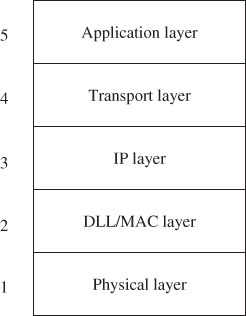1.2 From Network Layer to IP Layer
With the IP model, the community has established a five-layer model as shown in Figure 1.2, with the application layer, transport layer, IP layer, DLL/MAC layer, and the physical layer. In addition to the reduction of the OSI layers from seven to five layers, this model refers to the IP as “layer 3” and the DLL/MAC “layer 2” while the physical layer is layer 1.
Figure 1.2 The IP as the network layer with a five-layer OSI model.

Notice that the relationship between the network layer and the DLL/MAC is one-to-many. The network layer can send and receive packets from multiple DLL layers (links). This concept evolved with Internet Protocol to become an IP port. An IP router can also have ports dedicated to multiple workstations, servers, and so on, each with its own transport and session layers. As we dive into tactical networks learning about the tactical edge, we will debate the benefits of relying on the transport layer for reliability versus relying on the tactical edge IP layer, where aggregation of traffic allows us to exploit the benefits of statistical multiplexing in achieving reliability. You will also learn about addressing reliability at the transport layer, tactical edge, DLL, and/or through network coding. You will also be introduced to cross layer signaling through this five-layer model. You will see why IP-based tactical radios can ...
Get Tactical Wireless Communications and Networks: Design Concepts and Challenges now with the O’Reilly learning platform.
O’Reilly members experience books, live events, courses curated by job role, and more from O’Reilly and nearly 200 top publishers.

